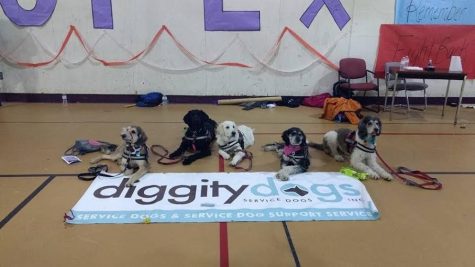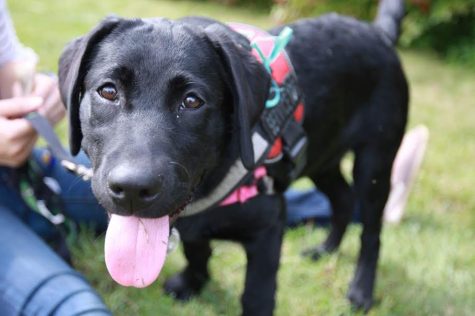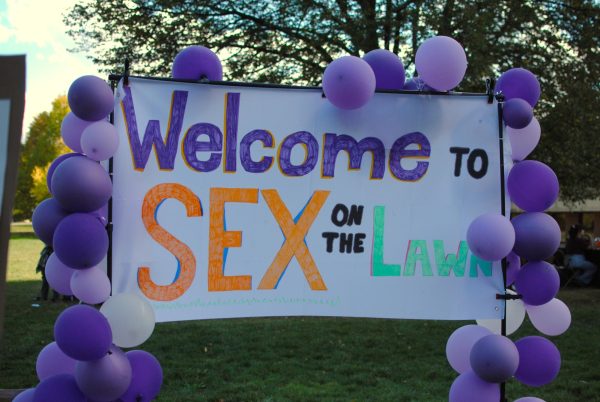Don’t pet her, she’s working
Mickey Fox, a sophomore journalism major at the University of Massachusetts Amherst, was carpooling to an internship with a friend who happened to be training a service dog. After a car ride bonding with the dog, Fox found himself curious about being a trainer. “The sum of my reaction was ‘oh my goodness, how do I get involved in this program?’” Fox said.
Fox’s friend explained how the program sets up applicants with a service dog, and by that afternoon he was sending in his application. Two days later, he got a message stating the date of the next training orientation.
With good timing in his favor, a new litter of service puppies had recently been born. Three weeks after that, in October 2016, he had a new roommate: an eight-week-old labradoodle named Ivy. “She could fit in a shoebox,” said Fox.
Fox, like other students, received a dog from Diggity Dogs Service Dogs Inc., an organization based in Shelburne Falls, Massachusetts. Diggity Dogs is dedicated to training service dogs and placing them with those in need.
While service animals are limited to dogs, types of emotional support animals include miniature horses, ferrets, potbelly pigs, parrots, capuchin monkeys and boa constrictors, according to the Americans with Disabilities Act. Service animals differ from emotional support animals because they help perform tasks that their owner’s disability may inhibit.
Service dogs can be trained to help many different disabilities, such as guiding blind people, signaling deaf people, assisting a person who is having a seizure, or calming someone during an anxiety attack.
Kerrin Hughes, a senior marketing major, often trains her black labradoodle, Kodak, for nightmare alerts. People with PTSD may suffer from intense nightmares, so service dogs are trained to alert to cues like moaning, sweating, thrashing and yelling in their sleep.
Hughes lies down, and has Kodak lick or nudge her chin whenever she exhibits the nightmare behavior, to wake her from the nightmare.
Diggity Dogs Service Dogs Inc. teamed up with the UMass animal science course, Service Dog Training. The course is in its third year. All majors are welcome to sign up for the three-credit course, but students must be approved to foster a dog from Diggity Dogs first.

The course was started by Dr. Amy Burnside, a research assistant professor, and Deborah Frenkel, a postdoctoral research fellow in the Department of Veterinary and Animal Sciences in collaboration with Dr. Janice Telfer.
Telfer is the instructor on record, since the university requires a faculty member to be logged for a course, but the director of Diggity Dogs, Sarah Meikle, teaches the class.
Frenkel serves as liaison between the university and Diggity Dogs, since she is a research fellow and is on the board of directors at Diggity Dogs. She meets with Telfer on a weekly basis to address the issues between student fosters and their dogs.
The very first student foster was Erin Riel, who graduated with a degree in animal sciences in 2017. She became a foster in January 2015, before the university was even involved in the process.
Meikle was weary of Riel taking on the responsibility of a service dog because she was a student, but agreed because she saw how dedicated Riel was. Riel took on training without any getting any credits from the university.
“She ended up being the best foster, and amazingly talented dog trainer. Through that we started getting more student fosters,” Frenkel said.
Especially in Riel’s courses in the Veterinary & Animal Sciences (VASCI) Department, students saw what she was doing and signed up to become fosters.
“Once we had ten or so dogs on campus with students it became really apparent that we needed to have a relationship with the university to have this whole process run smoothly and have the students not end up butting heads with the university,” Frenkel said.
In Massachusetts, service dogs currently in training are allowed the same public access rights as fully trained service dogs. It was important for the university to understand the legal responsibilities in service dog situations, along with what can be legally regulated.
For example, a professor or business owner may have an objection to an animal being brought in. “They have the right to ask the person with a dog ‘Is that a service dog?’ And then the person has to answer yes or no,” Telfer said. If the answer is no, the professor or business owner has the right to ask them to leave.
The VASCI department figured it would less confusing and frustrating for everyone if they created a link between service dogs and the university.
Frenkel and Burnside went to Telfer who agreed that it would be great for VASCI students to get contact with smaller animals, in comparison to the experience they were getting with farm animals.
A fair amount of VASCI students want go to vet school, according to Frenkel. “This was a way for them to have experience with small animals,” Frenkel said. “And a way for students who are busting their a** to do such a good job to get credit for that. Not just emotional credit, but university credit.”
Work like a dog
When Frenkel says students are working hard, she isn’t kidding.
“It’s not just like ‘oh I get to play with a puppy and have a pet.’ It’s very, very involved and it takes a lot of dedication and hard work. If it’s not something that you’re completely dedicated to, the cause, you’ll burn out on it and you won’t want to do it,” Frenkel said.
Fox can attest to that. “Training a dog is a 24/7 thing, you don’t get a break from it,” he said.
If Fox let his dog, Ivy, get away with misbehaving one time, she might continue to disobey Fox for the next six months.
“They’re like, ‘I got away with it once, I wonder if I can get away with it again,’” Fox said. “You have to be on your toes at all times, but it’s a very rewarding experience, I would not trade it for the world.”
A typical day for Hughes involves waking up and taking Kodak outside to go to the bathroom. Then she’ll pack his things for the day, including treats and poop bags. She might feed him before or after leaving, depending on how much of a rush she’s in.
“Then I’ll usually get ready, maybe eat breakfast,” Hughes said. “So, usually my day is focused around him.”
Depending on the day, Hughes either has her job or her internship to get to. She can’t bring Kodak with her to these, so she leaves him in the crate for a few hours. Once she finishes her shift, she comes home and lets Kodak out, and they make their way to campus for class.

Between her job, internship and school, Hughes is pretty busy. This leaves her with limited time to train Kodak, let alone relax.
“My [dog] classes are Tuesday night, so if it’s Monday night I realize I haven’t done any videos, so I’ll squeeze them all in,” she said.
And like most college students, sometimes Hughes is just plain tired.
“If I’m physically exhausted but I’m still awake, maybe I’ll do a nightmare alert where I can lay down but still be doing training,” Hughes said.
The Diggity Dogs training center in Shelburne Falls is a 40-minute drive from Amherst that student trainers make for their three-hour class. “Depending on the dog’s age that you have, you go to either a Monday class, Tuesday class, or a Wednesday class,” Fox said. Though the class only meets weekly, training is required every day.
“It’s actually more homework than a normal class,” Frenkel said.
Along with assigned readings and quizzes, the coursework includes filling out training logs. These logs chronicle any health and training issues or advancements, along with recording training videos where a performed task or socialization has been assigned.
Fox once had to submit a video where Ivy was “tasking” (practicing an action for training) around small animals, like those in a pet shop, who could serve as distractions.
Fox time-manages by exercising Ivy a lot early in the day to tire her out. “Later on in the day she would be napping and I would boggle down and do my homework. I also conditioned myself to survive on about four hours sleep at night so I could be doing my homework while she was asleep,” Fox said.
People occasionally quit the program, according to Fox. College students, especially the partiers, might not be able to handle the full-time responsibility of service training. “When you get involved your whole schedule starts to rotate around your dog,” Fox said.
Hitting the bars on a Friday night sounds ideal for some college students, but that wouldn’t be an ideal environment for the dogs. “Part of the reason why I didn’t quit the program was because I’m not much of a partier, I’m kind of more introverted,” Fox said.
Fox, with his blonde bangs falling over just over his glasses, speaks in a friendly, calm manner. Opting for more nights in as opposed to out makes him a good fit for a dog who needs plenty of attention. Going to crowded parties with beer pong cups overflowing and the Chainsmokers blasting would probably have his dog shaking in the corner.
“If that’s the sort of activities you like to do then the program might not be for you, because you have to be like, ‘Alright, well is my new puppy going to be able to handle this situation?’” Fox said. “’Am I going to be able to focus enough on them to make sure that they’re doing well, that they’re not stressed out, that I’m addressing any fearful behaviors they’re exhibiting right now?’”
If you need to have one characteristic when training a service dog, it’s patience. According to Frenkel, you need to have the ability to be positive even when you’re frustrated because it’s part of the curriculum to only use positive training techniques.
For example, if her dog jumps on the couch, Hughes will say “off” instead of “no.”
“It’s focusing on what they should be doing rather than what they shouldn’t be doing,” Hughes said.
Patience is definitely needed when the dogs are going through adolescence.
“Doggy adolescence is kind of like human adolescence as in they’re not going to listen to you, ever,” Fox said.
Lindsey Cloutier, a junior pre-veterinary major, often experiences frustration with her black labrador retriever, Makiah, her second dog with the program.
Cloutier will step away for a moment and collect herself before she goes back to training. “You can’t train a dog well if you yourself are not in a good place,” Cloutier said. “If you’re rushing somewhere, they’re not going to get as good training as if you were taking the time.”
Even when trainers get their breaks in the day, they still have to deal with issues. The dogs have crate time at least three hours a day.
Crate training in itself can be hard, according to Fox. Living in Butterfield Hall, he’s gotten his fair share of noise complaints from Ivy’s barking.
“That’s why you try and introduce everyone on the floor to your dog, so they can understand how cute your dog is,” Fox said. “Survival tactic.”
Hughes has a tactic similar to Fox’s, putting a sign on her door explaining who Kodak is. It helped her floormates understand why there are barks down the hall during quiet hours.
For halls that are not as understanding, Meikle will accompany students to their noise complaint meeting with their residential director and try to explain the situation.
Cloutier was in luck because her roommate, an animal science major, was on board with having a dog in the room. She would even help with Makiah when Cloutier needed some alone time.
“A lot of people also don’t realize that it’s a huge tax on your roommate too, because the crate takes a lot up space and all the dog stuff takes up space,” Cloutier said.
Barking up the wrong tree
Dealing with the dog itself is only part of being a trainer. You also have to deal with the people around you, especially on a huge campus like UMass.
The service dog training community refers people who are walking and reach out to touch the dog as “drive-by petters.” According to Fox, people sometimes get defensive asking, “why not,” when they are told not to touch the dogs. The answer, to Fox, is obvious: “because she’s working!”
“The goal is for them once they’re fully trained to be paying attention to their handler at all times, so they can catch physical cues like arm-scratching, shaking,” Fox said. If the dogs are constantly looking to be pet, then they won’t be attentive to their handler, which could put the handler’s life in danger.
That doesn’t mean that interacting with the dog is out of the question — just ask first. “Eighty five [to] 95 percent of the time if you ask permission to pet the dog or take a picture we’ll say yes,” Fox said.
Another thing the trainers deal with regularly is people attempting to sneak a picture of the dogs.
“It seems like in the beginning of the year it’s always the worst, because you have the freshmen and the people who have never really seen the dogs on campus before,” Cloutier said.
A quick picture might not seem like a big deal, but it can be really detrimental to the dogs’ training. When trainers spend the first few weeks getting the dogs to focus, it’s especially frustrating when a passerby makes kissy noises to get the dog to look at their camera.
“When people come up and reinforce them for looking at them, basically, it’s so annoying to us as fosters who have worked so hard on something,” Cloutier said.

The dogs’ constant attention is necessary so they can pick up on subtle cues, like a sharp breath or shaking legs, which alerts the dog that their handler needs assistance. “We basically want them checking in with us or looking at us as much as possible,” Hughes said.
Not only can picture taking distract the dog, but it can end up triggering their future owners.
Owners may suffer from anxiety or PTSD, and having a picture taken of them end up on social media may cause a panic attack, even if the picture was meant to be just of the dog.
While dealing with drive-by petters and dodging puppy Snapchatters on campus might be aggravating, it will happen no matter how apparent the service dog’s bright red vest is.
“As frustrating as it is, it’s a good thing. The dogs need this in their training because they’re going to experience this throughout their lives, anywhere they are,” Frenkel said. “They need to be solid for their professional life.”
Every dog has its day
Frenkel said that a lot of the students in the program have told her that it’s been one of the most enriching experiences in their college careers. Not only do they learn about the psychology of dogs and humans; they gain a new circle of friends.
Being on the UMass campus brings the trainers together in ways other students wouldn’t understand. “Once you have to wait for the nearest foster to come by bringing poop bags because you forgot your own…” Fox said. “It’s a tight-knit community.”
Even though training is an immense amount of work, Frenkel has noticed students being graced with a better-managed lifestyle. Acting as a caretaker of a dog has caused some student’s grades to improve and their anxiety to go down.
“The class itself kind of probably hurts my semester — like how it’s going — but he helps it,” Hughes said about Kodak.
Hughes will talk to Kodak on their walks to class, and calls him a “goofy” dog. “I love him, he’s my best friend,” she said.
As weeks passed, it became more real to Hughes that Kodak was going to end up with someone else. “I’m realizing how much he’s going to help this person. It puts more of a purpose to what I’m doing; it’s not like I’m just doing homework,” Hughes said.
But being a trainer is not simply a student-teacher relationship. “Don’t go into the program expecting not to get attached, because you’re going to get attached and it’s going to hurt,” Fox said.
Students spend so much time with their dogs, creating a bond. “You are going to have to say goodbye to this dog,” Fox said. “They are not going to be your dog, no matter how much you may wish it.”
Toward the end of the fall 2017 semester, Ivy graduated the program and was given to a 9-year-old boy.
“I was lucky enough to be able to meet the kid she was going to and I was very happy to be able to meet him and see how well they got along,” Fox said. “He loved her and she loved him.”
It hurt Fox to say goodbye, but the feeling of helping someone else has left him to continue the program until he graduates.
Cloutier said saying goodbye to her first dog, Bailey, was one of the hardest moments of her life. Yet being able to provide a change for someone’s life made her extremely grateful at the same time.
“I guess it was more of like this thing where I wanted to see her succeed,” Cloutier said. “If she had failed out or anything, I would have loved to have her as my dog, but she had a job to do that was more important then being with me.”
Realizing what all their hard work is going toward helps the trainers push through when times are stressful.
“The mission is about helping people with disabilities,” Frenkel said. “We love the dogs, we deal with the dogs every day all day, but it’s really important to keep in mind that the mission is to help people. And that’s why we’re training these dogs. It’s more than just a love of dogs.”
Email Jill at jmwebb@umass.edu.
Note: An update was made to clarify the difference between service dogs and other types of emotional support animals.










